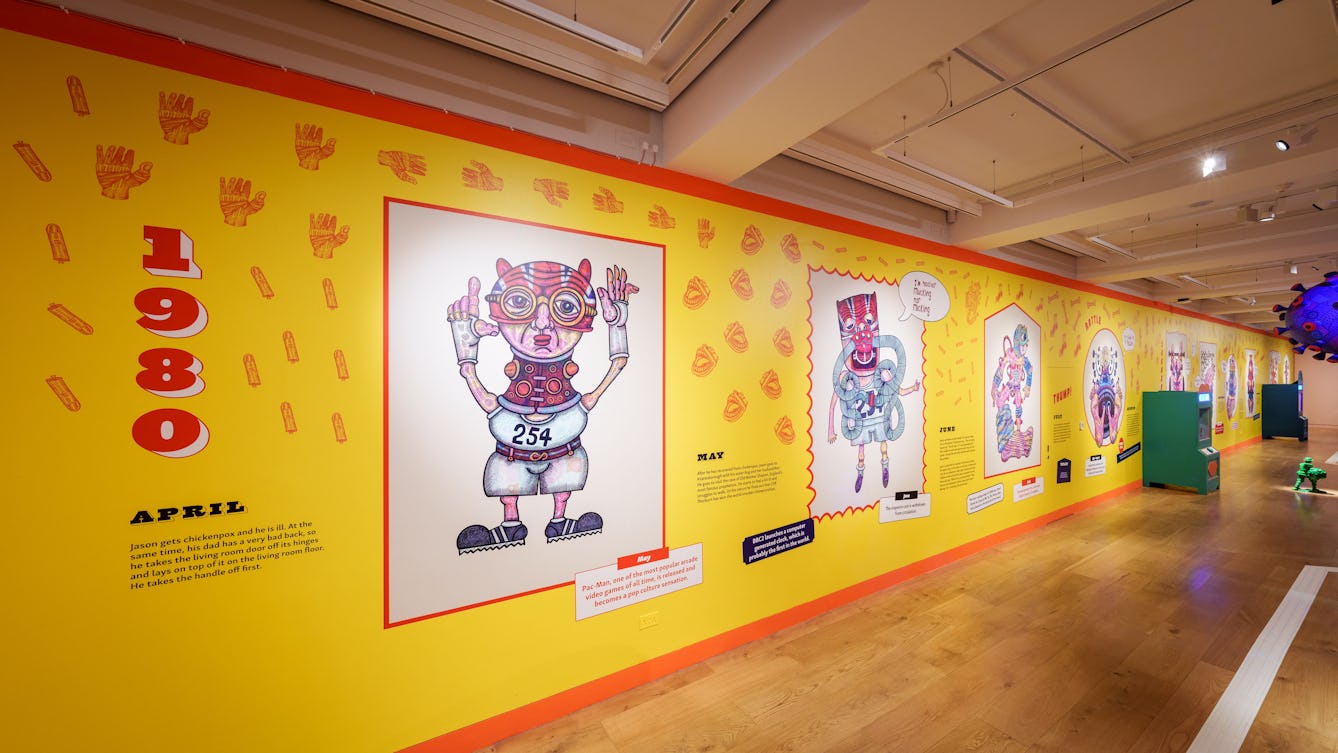Hi, my name is Shamita, I’m the curator of this exhibition. In this stop I’m going to tell you a bit more about the artist and what you’ll find in the show.
Jason Wilsher-Mills is an artist from Wakefield, in West Yorkshire in the UK.
On the 1st August 1980, at 2.54pm at Pinderfields Hospital, Wakefield, Wilsher-Mills witnessed his parents being told of his diagnosis of the autoimmune condition which paralysed him from the neck down between the ages of 11 and 16.
Unable to move, Jason’s interior world became inhabited by characters from comic strips and TV shows, entwined with his experiences of life both before and during his hospitalisation. Rather than remembering it as a time of trauma or loss, he sees it as the awakening of his creative life as an artist.
The installation in this colourful gallery is a dream-like distillation of Jason’s childhood memories of what was happening inside and outside of his body and within his imagination during this transformative time.
The long wall opposite the entrance is covered in a bright yellow wallpaper, bordered top and bottom in orange. The wallpaper features ten two-metre-high characters.
They’re hybrid creatures in a bold cartoonish style, part human, part medical machine or Dalek. Some have huge feet, multiple limbs, or they’re just a head with one bulging eye. They wear steampunk-style superhero masks, and have speech and thought bubbles. Lettering indicates sounds – for example a line of Zs for snoring.
Wilsher-Mills is the youngest of eight children from a working-class family. Family occupies a central importance in his life and was a key connection to the outside world while he was in hospital. Through the hospital school he also gained new educational experiences which he credits as being instrumental in his path to becoming an artist.
In his work Jason explores narratives of disability, health and identity, using playful humour and colourful magic realism. Taking inspiration from sources as diverse as The Beano and Charles Dickens, and making reference to the ancient Greek hero after who he was named, Wilsher-Mills creates new ways of storytelling that reflect the social model of disability – that people are disabled by social, economic and physical barriers.
The gallery is a riot of colour, packed with an array of playful and sometimes irreverent characters and objects.
Red and purple inflatable ‘viruses’ hang over our heads. They’re beach-ball sized and covered with sucker-like appendages.
Three sculptures occupy the central floor space – an enormous pair of lavishly decorated calliper boots over two metres high, an athlete with a giant telly for a head, and a huge figure lying in a four-metre-long hospital bed. Jason talks about these sculptures in stops 3, 4 and 5.
There are coloured fairground lights on the figure which light up when you press a button.
Placed on the floor in between are ten models of green toy soldiers, about 60cm high. Like everything else in the gallery, these can be touched. They’re mid stride, wearing helmets and each carries a virus under their arm.
Against the gallery walls are nine two-metre-high, brightly coloured cabinets. The cabinets are reminiscent of the penny arcade machines Wilsher-Mills remembers from family holidays at the seaside resort of Withernsea in Yorkshire and Humber. They’re made of a smooth material, etched with patterns in a contrasting colour, on the top and bottom panels. They have a window in the top half which contains a diorama, a three-dimensional scene constructed of cut-outs, spaced out from front to back, like a miniature toy theatre.
The softly lit diorama scenes are richly decorated with colour, complex patterns, and packed with detail. Jason talks about some of these dioramas in stops 6 to 10. They act as windows into Jason’s childhood memories before and during his hospitalisation. They are not straightforward depictions but are infused with a dream-like magic realism where myth and memory become merged.
They are rich in symbolism and denote stages of transformation in his life, from childhood, through puberty, to changes in his health, and his creative journey.
Each diorama has a lit-up coloured button just under the window, which you can press to brighten the lights on the scene inside, illuminating these glimpses into Jason’s inner world.
Everything in the gallery can be touched, so feel free to explore and enjoy.
Stop 3 is the calliper boots. Follow the tactile floor line to arrive there.
